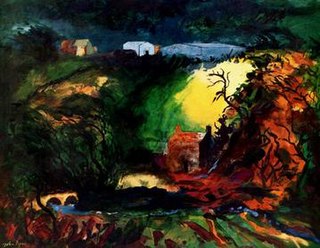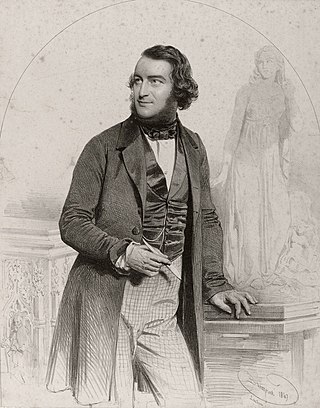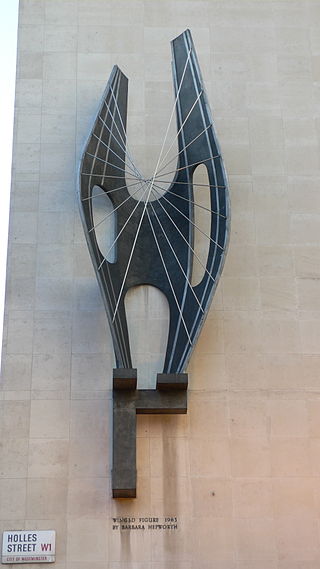
Hubert Cyril Dalwood ARA (2 June 1924 – 2 November 1976) was a British sculptor. He was widely known as 'Nibs'. [1]

Hubert Cyril Dalwood ARA (2 June 1924 – 2 November 1976) was a British sculptor. He was widely known as 'Nibs'. [1]
Dalwood was born on 2 June 1924 at 78 Whiteladies Road, Clifton, Bristol. He was apprenticed to the Bristol Aeroplane Company (1940–44), and attended the Bristol School of Art part-time. After national service in the Royal Navy, he studied at Bath Academy of Art. He was a teacher of sculpture at several institutions over the years. In 1956 he was one of the first members of the 56 Group Wales. [2]
He married Mary Nicolson and they had two daughters. They divorced in 1963 and he married Caroline Gaunt with whom he had two sons. They divorced in 1974. He died 2 November 1976 in St Bartholomew's Hospital, London. [1]

In 1959 he won first prize at the John Moores exhibition in Liverpool for his ovoid Large Object and won the David Bright prize at the 1962 Venice Biennale. [1] From 1959 to 1962 he was engaged on a commission to construct a large cast aluminium relief mural (6.4 x 6.1 m) for the new Bodington Hall student accommodation complex at the University of Leeds. The significance of this work was considered such that the building was scheduled Grade II listed on grounds that he was a leading sculptor; it represented his first large scale output in his great period, and its high aesthetic quality. [3] When the Hall was demolished, the mural was transferred to another University of Leeds building. [3]


Sir Jacob Epstein was an American-British sculptor who helped pioneer modern sculpture. He was born in the United States, and moved to Europe in 1902, becoming a British subject in 1910.

John Egerton Christmas Piper CH was an English painter, printmaker and designer of stained-glass windows and both opera and theatre sets. His work often focused on the British landscape, especially churches and monuments, and included tapestry designs, book jackets, screen-prints, photography, fabrics and ceramics. He was educated at Epsom College and trained at the Richmond School of Art followed by the Royal College of Art in London. He turned from abstraction early in his career, concentrating on a more naturalistic but distinctive approach, but often worked in several different styles throughout his career.
Frank Owen Dobson was a British artist and sculptor. Dobson began as a painter, and his early work was influenced by cubism, vorticism, and futurism. After World War I, however, he turned increasingly toward sculpture in a more or less realist style. Throughout the 1920s and the early 1930s he built a reputation as an outstanding sculptor and was among the first in Britain to prefer direct carving of the material rather than modelling a maquette first. The simplified forms and flowing lines of much of his sculptures, particularly his female nudes, showed the influence of African art. From 1946 to 1953 Dobson was Professor of Sculpture at the Royal College of Art. He was elected to the Royal Academy in 1953. While Dobson was one of the most esteemed artists of his time, after his death his reputation declined with the move towards postmodernism and conceptual art. However, in recent years a revival has begun. Dobson is now seen as one of the most important British sculptors of the 20th century.

The Haymarket Shopping Centre is a shopping centre in the city centre of Leicester, England. It was opened on 4 June 1973 as part of the Haymarket Centre and was the country's second shopping centre after the Bull Ring, Birmingham. It is located east of and adjacent to the Clock Tower.

Ceri Giraldus Richards was a Welsh painter, print-maker and maker of reliefs.


Henry Spencer Moore was an English artist. He is best known for his semi-abstract monumental bronze sculptures which are located around the world as public works of art. Moore also produced many drawings, including a series depicting Londoners sheltering from the Blitz during the Second World War, along with other graphic works on paper.

John Thomas (1813–1862) was a British sculptor and architect, who worked on Buckingham Palace and the Palace of Westminster.
David Wynne was a British sculptor of figures, animals, and portraits.
Eric Craven Gregory, also known as Peter Gregory, was a publisher and benefactor of modern art and artists.

Draped Seated Woman 1957–58 is a bronze sculpture by the British artist Henry Moore, cast in an edition of seven in the 1950s. The sculpture depicts a female figure resting in a seated position, with her legs folded back to her right, her left hand supporting her weight, and her right hand on her right leg. The drapery emphasises the female figure, but the facial features are abstracted and barely picked out.

Draped Reclining Woman 1957–58 is a bronze sculpture by British artist Henry Moore, with a series of six castings made by Hermann Noack in Berlin.

Ralph Brown was an English sculptor who came to national prominence in the late 1950s with his large-scale bronze Meat Porters, commissioned for Harlow New Town, Essex and is known for his sensual, figurative sculptures.

Winged Figure is a 1963 sculpture by British artist Barbara Hepworth. One of Hepworth's best known works, it has been displayed in London since April 1963, on Holles Street near the junction with Oxford Street, mounted on the south-east side of the John Lewis department store. It is estimated that the sculpture is seen by approximately 200 million people each year.

Reclining Figure: Festival is a bronze sculpture by English artist Henry Moore, commissioned by the Arts Council in 1949 for the Festival of Britain in 1951. The sculpture can be viewed as an abstraction of a reclining female human figure, resting on two arms, with a small head.
Meridian is a bronze sculpture by British artist Barbara Hepworth. It is an early example of her public commissions, commissioned for State House, a new 16-storey office block constructed at 66–71 High Holborn, London, in the early 1960s. The sculpture was made in 1958–59, and erected in 1960. When the building was demolished in 1990, the sculpture was sold and moved to the Donald M. Kendall Sculpture Gardens in Purchase, New York.

Recumbent Figure 1938 (LH191) is an early sculpture by Henry Moore. It was commissioned by the architect Serge Chermayeff for his modernist villa at Bentley Wood, near Halland, Sussex. At the time it was made, it was Moore's largest stone sculpture. It was donated to the Tate Gallery in 1939, making it the first example of Moore's work in a public collection.

Family Group is a sculpture by Henry Moore. It was his first large-scale bronze sculpture, and his first large bronze with multiple castings. Made for Barclay School in Stevenage, it evolved from drawings in the 1930s, through a series of models to bronze castings in 1950–51. It also one of the last important sculptures that Moore developed from preliminary drawings: in future, he worked mainly from found objects, maquettes and models.
UNESCO Reclining Figure 1957–58 is a sculpture by Henry Moore. It was made in a series of scales, from a small plaster maquette, through a half-size working model made in plaster and cast in bronze, to a full-size version carved in Roman travertine marble in 1957–1958. The final work was installed in 1958 at the World Heritage Centre, the headquarters of UNESCO at the Place de Fontenoy in Paris. This was Moore's last major public commission in which he created a new work for a specific site; he afterwards generally worked from an existing sketch or model.

Reclining Figure (Lincoln Center) (LH 519) is a statue by Henry Moore. The original two-part bronze statue of a human figure was commissioned for the Lincoln Center for the Performing Arts in New York City, where it has been displayed outdoors since 1965 in a pool of water to the north of the new Metropolitan Opera House. Other copies in plaster or bronze exist, and are displayed in other cities.